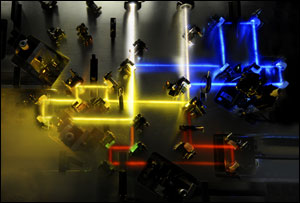
Light Synthesizer Divides Visible Wavelengths
MUNICH, Sept. 15, 2011 — In an essential step forward in light technology and ultrafast photonics, a team at the Max Planck Institute of Quantum Optics (MPQ) and Ludwig Maximilians University controlled the field of white light pulses on a timescale shorter than an optical oscillation. Such precise control of ultrashort light fields could lead to light-based electronics.
Monitoring the ultrafast motion of the electrons requires ultrashort flashes of light. However, to control them, the structure of these light flashes, or light pulses, must be tamed as well. Physicists, led by Eleftherios Goulielmakis and Ferenc Krausz, managed to sculpt waveforms of laser pulses with subcycle precision, enabling them to make their pulses shorter than a complete light oscillation, thereby creating, for the first time, isolated sub-optical-cycle flashes of light.

Mixing light: A light field synthesizer divides incident white light into three color channels and modifies it afterward. The composition creates laser pulses with a complex, however fine, adjustable waveform. (Image: Thorsten Naeser)
To control the light pulses on a subcycle time scale, they used white laser light because it contains wavelengths ranging from near-ultraviolet to the near-infrared region of the electromagnetic spectrum. The physicists created these light pulses and sent them into a newly developed “light field synthesizer” that superimposes optical waves of different colors and phases to create various field shapes. The apparatus first splits the incident white laser light into red, yellow and blue color channels. After manipulating the properties of the individual colors, they are recombined to form the synthesized waveform.
Utilizing this technology, the scientists generated completely new isolated waveforms and, in so doing, composed the shortest pulses ever measured in the visible spectral range — 2.1 fs. These pulses are more intense than the ones commonly afforded by current femtosecond light sources because all the energy of the electromagnetic field is confined into a tiny temporal window. Thus, the strength of the electromagnetic forces also increases.
It is precisely these powerful and specially tailored electromagnetic forces that are necessary to control electrons in atoms and molecules, as they are similar in strength to the forces occurring in such microscopic systems. However, to steer electron motion on a microscopic scale, another prerequisite is precision. This desired level of precision is provided by the well-controlled waveforms of the synthesized light pulses.
“These newly developed tools allow us to initiate, control and therefore further understand inner-atomic processes,” said Adrian Wirth, a postdoctoral fellow on the research team of Eleftherios Goulielmakis at MPQ. “With these devices, we can master the fine structuring of ultrashort light fields and reliably measure the newly formed light.”
The physicists have already applied this novel technique in an experiment. By shining the newly designed light pulses onto krypton atoms, the outermost electron was ripped away within less than 700 attoseconds, marking the fastest electronic process that has been initiated by optically visible light.
“This new technology may very well lead the way towards light-based electronics in the future,” said Goulielmakis. “Light fields are expected to drive electrons not only in isolated systems such as atoms or molecules but even on microscopic circuits so as to perform logic operations at unprecedented speeds.”
For more information, visit: www.mpq.mpg.de
Published: September 2011